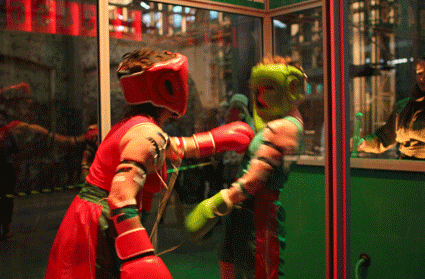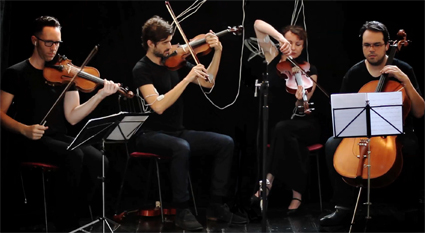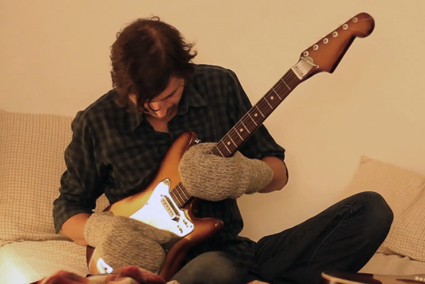 |
Game On, Michaela Davies photos Claire Conroy & Geoff Ambler |
Involuntary art & vicarious violence
Game On extends the work that Davies has been making with electric muscle stimulation (EMS), in particular her Compositions for Involuntary Strings. She composes works that are translated into midi data, then converted to EMS messages that are transmitted to the wired-up musicians who are literally shocked into playing the compositions, their involuntary muscle spasms providing wonderfully idiosyncratic extra musical sounds. (See RT113 and our ISEA blog).
For Game On, Davies uses a similar EMS technique, but ups the ante considerably. Inspired by a scene in Richard T Heffron’s film Future World (1973), she built a gaming booth in which live ‘boxers’ are controlled by audience members via oversized joysticks. The boxers’ muscles are stimulated into sequences that replicate the action of swinging, punching and blocking. The resulting match is curiously languid and hysterically wonky. Things hot up as the controlling masters of the game get increasingly more skilled and sometimes more aggressive.
GAME ON. Documentation from installation on Cockatoo Island for Underbelly Arts Festival. Sydney, Australia (2013), video by Boris Bagattini from Michaela Davies on Vimeo.
While the piece is evidently fun, it also poses questions about our pleasure in vicarious violence. The work also references the infamous Milgram experiment, in which people were given permission by a perceived authority figure to inflict lethal levels of electric current on unseen participants. In the Milgram experiment there were no actual victims (the participants’ cries were revealed to be pre-recorded), so Davies’ piece, in effect, takes this experiment a step further. Game On also removes the authority figure but replaces it with the performance context. Davies says: “the authority comes from the fact that it’s an artwork—they are doing it for art. But it’s still looking at where the responsibility lies. Maybe the players wouldn’t go up and shock someone on the street but because they’ve been given permission here, that makes it okay for them.”Game On illustrates an interesting tension between Davies’ psychology and art practices: “There’s no way you could do something like Game On in a research environment, or as a psychological study because of ethics. Making art you have more freedom to explore ideas that you can’t explore in research because you simply wouldn’t be allowed. Or it would be so far removed from any kind of reality that it would be pointless. I’m wondering how long [this freedom] will last before artists will have to submit ethics applications to make an artwork that involves the public.” [This is already an issue for art practice as research within universities; see Kate McNeill and Barbara Bolt, “The ‘legitimate’ limits of artistic practice,” RealTime 104, Eds]
 |
"Untitled for Cyborg String Quartet" (voluntary & involuntary players), Michaela Davies in collaboration with Kyle Sanna |
Obstructionism
Game on and the Involuntary Strings project are of course about more than sadism: they reflect Davies’ overarching interest in agency and free will. Her next project involves a series of videos in which musicians play a piece which they know very well but have to battle an obstruction—for example a guitarist wears mittens while trying to play “Stairway to Heaven.” Davies says, “I am interested in the way obstruction can change performance, or change behaviour—how people cope with different obstruction. I’m also looking at this from an historical experimental music perspective—chance operations… Those artists were trying to remove people from what they’re making, to give them more freedom—through obstruction—to create something new.”
A work Davies is developing for her appearance at the Sonica Festival in Glasgow will involve a pianist performing a classic piece (yet to be decided) which Davies, in a duet of sorts, will interrupt with EMS impulses. She says, “She’ll be fighting against the involuntary EMS to try and play. I’m really interested in that struggle.” With this and the video pieces Davies is “interested how performance becomes a recital. It’s easy for musicians to not really think about what they’re playing any more. I’m looking at ways of changing that.” In the early Involuntary Strings pieces it seems musicians voluntarily relinquish control. In these later works Davies allows the musicians a semblance of control and then actively interferes with it.
 |
Kyle Sanna plays Stairway to Heaven, Michaela Davies courtesy the artists |
COMING UP: Sonica: Compositions for Involuntary Strings, Tramway, Glasgow, 2 November; http://sonic-a.co.uk/compositions-for-involuntary-strings/; Game On, Damien Minton Ballery, opening 12 November; http://www.michaeladavies.net/
RealTime issue #116 Aug-Sept 2013 pg. web
© Gail Priest; for permission to reproduce apply to [email protected]








 back
back